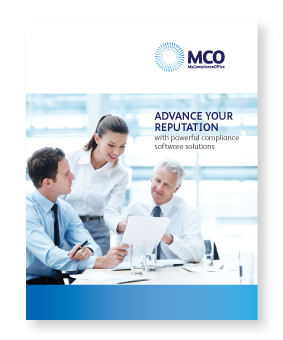Building blocks of an anti-corruption & bribery framework
You can download a full copy of the slides from this webinar.
Full video transcript available below:
|
Welcome and thank you for joining today's webinar, hosted by me, Bethany Sirven of MyComplianceOffice and Robin Singh. Today's webinar will cover reasons why anticorruption programs fail, practical ways to strengthen an anticorruption practice that needs to be incorporated, advise on how to improve your existing program, and we'll end with a live Q&A section to answer your questions. |
|
Now, allow me to introduce my co-host today, Robin Singh |
|
Do you believe there is an over-reliance on the compliance program? We will have another 10 seconds before we close the polls. |
|
Okay. Interesting stats. What I believe is compliance programs sometimes can lead to a false sense of security, especially if the compliance programs are taken off the shelf which a lot of compliance officers do or they're poorly implemented or they're not customized to the working environment or to the economic zone of the country that they are operating it. These all tend to create a lot of loopholes in the program and does at times management tend to over-rely on these programs. |
|
With that, let's look at the next slide which is to cover the objectives, the next one. Before we deep-dive into the objective. We will move on level upwards. When I say one level upwards, I mean to look at the overarching umbrella under which anticorruption program rely and that is the ethics and compliance program. |
|
The objective of such a program is very basic. Basically to ensure a culture of integrity and honestly. Obviously, this cannot be achieved overnight. There's a journey and some of the nut and bolts of this framework, I would explain in the next slide. However, the bottom line is to get your employees to believe in a system. A system of doing the right thing when no one is watching. A system so strong that employees would choose to do the right thing even if no rule exist in that area. |
|
Now, this slide represents the basic elements of a compliance program. I'll try my best to summarize this slide because the whole compliance program might just take another webinar. Let's start. The whole idea is to ensure that compliance is with various laws, regulations. In short, various sources. Once you have established your sources, you would carry out a compliance risk assessment which will cover all possible risks and which will also include the risk of corruption, bribery, et cetera. Finally, you would drive some actions and address those actions over a period of time. The next level is to empower your employees by providing them the tools. One such tool is obviously the reporting outline which is also used as a monitoring tool. The other tools being the policy procedures, well-written guidelines, et cetera. Finally, to the monitoring mechanism where you would monitor various activities. Maybe conflict of interest, maybe employees reporting sponsorship paid by the vendors, or gifts and entertainment received, et cetera. |
|
Importantly, the monitoring phase is the phase which would tell you how good is your program. During the monitoring phase, you would need to audit your program itself in order to see if it is working well, is it customized according to your operation, to the the country requirements, and the like. The bluish gray triangle that you see in your background, that represents risk and laws. As you see in the beginning, those are very broad because it's an unknown quantity, but as you move towards the monitoring phase, the size reduces. That means you are getting the risk and the understanding of laws and their applicability under control. Finally, they are going to be those employees who definitely crossed the line. You will carry out investigation and make sure they're disciplined. |
|
One of the true test of a compliance program is to ensure that you don't have high number of investigations because if you're having high number of investigations, this means that your framework is failing somewhere. It is not adequate. Finally, you should be able to manage most of the situation at the monitoring stage and that's what shows the maturity of a compliance program. |


